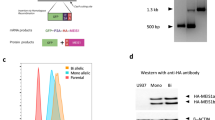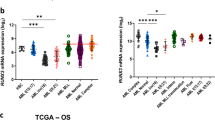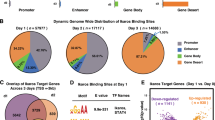Abstract
Wilms’ tumor gene 1 (WT1) is a transcription factor involved in developmental processes. In adult hematopoiesis, only a small portion of early progenitor cells express WT1, whereas most leukemias show persistently high levels, suggesting an oncogenic role. We have previously characterized oncogenic BCR/ABL1 tyrosine kinase signaling pathways for increased WT1 expression. In this study, we show that overexpression of BCR/ABL1 in CD34+ progenitor cells leads to reduced expression of interferon regulatory factor 8 (IRF8), in addition to increased WT1 expression. Interestingly, IRF8 is known as a tumor suppressor in some leukemias and we investigated whether WT1 might repress IRF8 expression. When analyzed in four leukemia mRNA expression data sets, WT1 and IRF8 were anticorrelated. Upon overexpression in CD34+ progenitors, as well as in U937 cells, WT1 strongly downregulated IRF8 expression. All four major WT1 splice variants induced repression, but not the zinc-finger-deleted WT1 mutant, indicating dependence on DNA binding. A reporter construct with the IRF8 promoter was repressed by WT1, dependent on a putative WT1-response element. Binding of WT1 to the IRF8 promoter was demonstrated by chromatin immunoprecipitation. Our results identify IRF8 as a direct target gene for WT1 and provide a possible mechanism for oncogenic effects of WT1 in leukemia.
This is a preview of subscription content, access via your institution
Access options
Subscribe to this journal
Receive 12 print issues and online access
$259.00 per year
only $21.58 per issue
Buy this article
- Purchase on Springer Link
- Instant access to full article PDF
Prices may be subject to local taxes which are calculated during checkout






Similar content being viewed by others
Accession codes
References
Lee SB, Haber DA . Wilms tumor and the WT1 gene. Exp Cell Res 2001; 264: 74–99.
Scharnhorst V, van der Eb AJ, Jochemsen AG . WT1 proteins: functions in growth and differentiation. Gene 2001; 273: 141–161.
Fraizer GC, Patmasiriwat P, Zhang X, Saunders GF . Expression of the tumor suppressor gene WT1 in both human and mouse bone marrow. Blood 1995; 86: 4704–4706.
Baird PN, Simmons PJ . Expression of the Wilms’ tumor gene (WT1) in normal hemopoiesis. Exp Hematol 1997; 25: 312–320.
Maurer U, Brieger J, Weidmann E, Mitrou PS, Hoelzer D, Bergmann L . The Wilms’ tumor gene is expressed in a subset of CD34+ progenitors and downregulated early in the course of differentiation in vitro. Exp Hematol 1997; 25: 945–950.
Menssen HD, Renkl HJ, Entezami M, Thiel E . Wilms’ tumor gene expression in human CD34+ hematopoietic progenitors during fetal development and early clonogenic growth. Blood 1997; 89: 3486–3487.
Hosen N, Sonoda Y, Oji Y, Kimura T, Minamiguchi H, Tamaki H et al. Very low frequencies of human normal CD34+ haematopoietic progenitor cells express the Wilms’ tumour gene WT1 at levels similar to those in leukaemia cells. Br J Haematol 2002; 116: 409–420.
Hosen N, Shirakata T, Nishida S, Yanagihara M, Tsuboi A, Kawakami M et al. The Wilms’ tumor gene WT1-GFP knock-in mouse reveals the dynamic regulation of WT1 expression in normal and leukemic hematopoiesis. Leukemia 2007; 21: 1783–1791.
Alberta JA, Springett GM, Rayburn H, Natoli TA, Loring J, Kreidberg JA et al. Role of the WT1 tumor suppressor in murine hematopoiesis. Blood 2003; 101: 2570–2574.
Nishida S, Hosen N, Shirakata T, Kanato K, Yanagihara M, Nakatsuka S et al. AML1-ETO rapidly induces acute myeloblastic leukemia in cooperation with Wilms’ tumor gene, WT1. Blood 2005; 107: 3303–3312.
Miwa H, Beran M, Saunders GF . Expression of the Wilms’ tumor gene (WT1) in human leukemias. Leukemia 1992; 6: 405–409.
Miyagi T, Ahuja H, Kubota T, Kubonishi I, Koeffler HP, Miyoshi I . Expression of the candidate Wilm's tumor gene, WT1, in human leukemia cells. Leukemia 1993; 7: 970–977.
Inoue K, Sugiyama H, Ogawa H, Nakagawa M, Yamagami T, Miwa H et al. WT1 as a new prognostic factor and a new marker for the detection of minimal residual disease in acute leukemia. Blood 1994; 84: 3071–3079.
Menssen HD, Renkl HJ, Rodeck U, Maurer J, Notter M, Schwartz S et al. Presence of Wilms’ tumor gene (wt1) transcripts and the WT1 nuclear protein in the majority of human acute leukemias. Leukemia 1995; 9: 1060–1067.
Inoue K, Tamaki H, Ogawa H, Oka Y, Soma T, Tatekawa T et al. Wilms’ tumor gene (WT1) competes with differentiation-inducing signal in hematopoietic progenitor cells. Blood 1998; 91: 2969–2976.
Svedberg H, Chylicki K, Baldetorp B, Rauscher 3rd FJ, Gullberg U . Constitutive expression of the Wilms’ tumor gene (WT1) in the leukemic cell line U937 blocks parts of the differentiation program. Oncogene 1998; 16: 925–932.
Tsuboi A, Oka Y, Ogawa H, Elisseeva OA, Tamaki H, Oji Y et al. Constitutive expression of the Wilms’ tumor gene WT1 inhibits the differentiation of myeloid progenitor cells but promotes their proliferation in response to granulocyte-colony stimulating factor (G-CSF). Leuk Res 1999; 23: 499–505.
Yang L, Han Y, Suarez Saiz F, Minden MD . A tumor suppressor and oncogene: the WT1 story. Leukemia 2007; 21: 868–876.
Tamura T, Yanai H, Savitsky D, Taniguchi T . The IRF family transcription factors in immunity and oncogenesis. Annu Rev Immunol 2008; 26: 535–584.
Schmidt M, Nagel S, Proba J, Thiede C, Ritter M, Waring JF et al. Lack of interferon consensus sequence binding protein (ICSBP) transcripts in human myeloid leukemias. Blood 1998; 91: 22–29.
Holtschke T, Lohler J, Kanno Y, Fehr T, Giese N, Rosenbauer F et al. Immunodeficiency and chronic myelogenous leukemia-like syndrome in mice with a targeted mutation of the ICSBP gene. Cell 1996; 87: 307–317.
Hao SX, Ren R . Expression of interferon consensus sequence binding protein (ICSBP) is downregulated in Bcr-Abl-induced murine chronic myelogenous leukemia-like disease, and forced coexpression of ICSBP inhibits Bcr-Abl-induced myeloproliferative disorder. Mol Cell Biol 2000; 20: 1149–1161.
Tamura T, Kong HJ, Tunyaplin C, Tsujimura H, Calame K, Ozato K . ICSBP/IRF-8 inhibits mitogenic activity of p210 Bcr/Abl in differentiating myeloid progenitor cells. Blood 2003; 102: 4547–4554.
Burchert A, Cai D, Hofbauer LC, Samuelsson MK, Slater EP, Duyster J et al. Interferon consensus sequence binding protein (ICSBP; IRF-8) antagonizes BCR/ABL and down-regulates bcl-2. Blood 2004; 103: 3480–3489.
Schwieger M, Lohler J, Friel J, Scheller M, Horak I, Stocking C . AML1-ETO inhibits maturation of multiple lymphohematopoietic lineages and induces myeloblast transformation in synergy with ICSBP deficiency. J Exp Med 2002; 196: 1227–1240.
Gurevich RM, Rosten PM, Schwieger M, Stocking C, Humphries RK . Retroviral integration site analysis identifies ICSBP as a collaborating tumor suppressor gene in NUP98-TOP1-induced leukemia. Exp Hematol 2006; 34: 1192–1201.
Konieczna I, Horvath E, Wang H, Lindsey S, Saberwal G, Bei L et al. Constitutive activation of SHP2 in mice cooperates with ICSBP deficiency to accelerate progression to acute myeloid leukemia. J Clin Invest 2008; 118: 853–867.
Koenigsmann J, Rudolph C, Sander S, Kershaw O, Gruber AD, Bullinger L et al. Nf1 haploinsufficiency and ICSBP deficiency synergize in the development of leukemias. Blood 2009; 113: 4690–4701.
Schmidt M, Bies J, Tamura T, Ozato K, Wolff L . The interferon regulatory factor ICSBP/IRF-8 in combination with PU.1 up-regulates expression of tumor suppressor p15(Ink4b) in murine myeloid cells. Blood 2004; 103: 4142–4149.
Edvardsson L, Dykes J, Olsson ML, Olofsson T . Clonogenicity, gene expression and phenotype during neutrophil versus erythroid differentiation of cytokine-stimulated CD34+ human marrow cells in vitro. Br J Haematol 2004; 127: 451–463.
Ginzinger DG . Gene quantification using real-time quantitative PCR: an emerging technology hits the mainstream. Exp Hematol 2002; 30: 503–512.
Valk PJ, Verhaak RG, Beijen MA, Erpelinck CA, Barjesteh van Waalwijk van Doorn-Khosrovani S, Boer JM et al. Prognostically useful gene-expression profiles in acute myeloid leukemia. N Engl J Med 2004; 350: 1617–1628.
Metzeler KH, Hummel M, Bloomfield CD, Spiekermann K, Braess J, Sauerland MC et al. An 86-probe-set gene-expression signature predicts survival in cytogenetically normal acute myeloid leukemias. Blood 2008; 112: 4193–4201.
Verhaak RG, Wouters BJ, Erpelinck CA, Abbas S, Beverloo HB, Lugthart S et al. Prediction of molecular subtypes in acute myeloid leukemia based on gene expression profiling. Haematological 2009; 94: 131–134.
Zheng C, Li L, Haak M, Brors B, Frank O, Giehl M et al. Gene expression profiling of CD34+ cells identifies a molecular signature of chronic myeloid leukemia blast crisis. Leukemia 2006; 20: 1028–1034.
Svensson E, Vidovic K, Lassen C, Richter J, Olofsson T, Fioretos T et al. Deregulation of the Wilms’ tumour gene 1 protein (WT1) by BCR/ABL1 mediates resistance to imatinib in human leukaemia cells. Leukemia 2007; 21: 2485–2494.
Cilloni D, Messa F, Gottardi E, Fava M, Arruga F, Defilippi I et al. Sensitivity to imatinib therapy may be predicted by testing Wilms tumor gene expression and colony growth after a short in vitro incubation. Cancer 2004; 101: 979–988.
Rong Y, Cheng L, Ning H, Zou J, Zhang Y, Xu F et al. Wilms’ tumor 1 and signal transducers and activators of transcription 3 synergistically promote cell proliferation: a possible mechanism in sporadic Wilms’ tumor. Cancer Res 2006; 66: 8049–8057.
Egwuagu CE, Li W, Yu CR, Che Mei Lin M, Chan CC, Nakamura T et al. Interferon-gamma induces regression of epithelial cell carcinoma: critical roles of IRF-1 and ICSBP transcription factors. Oncogene 2006; 25: 3670–3679.
Yang D, Thangaraju M, Browning DD, Dong Z, Korchin B, Lev DC et al. Repression of IFN regulatory factor 8 by DNA methylation is a molecular determinant of apoptotic resistance and metastatic phenotype in metastatic tumor cells. Cancer Res 2007; 67: 3301–3309.
McGough JM, Yang D, Huang S, Georgi D, Hewitt SM, Röcken C et al. DNA methylation represses IFN-gamma-induced and signal transducer and activator of transcription 1-mediated IFN regulatory factor 8 activation in colon carcinoma cells. Mol Cancer Res 2008; 6: 1841–1851.
Gebhard C, Schwarzfischer L, Pham TH, Andreesen R, Mackensen A, Rehli M . Rapid and sensitive detection of CpG-methylation using methyl-binding (MB)-PCR. Nucleic Acids Res 2006; 34: e82.
Tshuikina M, Nilsson K, Oberg F . Positive histone marks are associated with active transcription from a methylated ICSBP/IRF8 gene. Gene 2008; 410: 259–267.
Lee KY, Geng H, Ng KM, Yu J, van Hasselt A, Cao Y et al. Epigenetic disruption of interferon-gamma response through silencing the tumor suppressor interferon regulatory factor 8 in nasopharyngeal, esophageal and multiple other carcinomas. Oncogene 2008; 27: 5267–5276.
Laity JH, Dyson HJ, Wright PE . Molecular basis for modulation of biological function by alternate splicing of the Wilms’ tumor suppressor protein. Proc Natl Acad Sci USA 2000; 97: 11932–11935.
Algar EM, Khromykh T, Smith SI, Blackburn DM, Bryson GJ, Smith PJ . A WT1 antisense oligonucleotide inhibits proliferation and induces apoptosis in myeloid leukaemia cell lines. Oncogene 1996; 12: 1005–1014.
Acknowledgements
We thank Dr Thoas Fioretos (Lund, Sweden) for providing us with the KU812, LAMA-84 and JK-1 cell lines and Dr F Rauscher III (Philadelphia, PA) for the kind gift of the pCMV-CB6+/WT1 (+17aa, -KTS) plasmid. This study was supported by grants from the Medical Faculty of Lund (ALF), the Swedish Cancer Society, the Swedish Research Council, the Swedish Children's Cancer Foundation, the Gunnar Nilsson Cancer Foundation, the Österlund Foundation and funds from Lund University Hospital.
Author information
Authors and Affiliations
Corresponding author
Ethics declarations
Competing interests
The authors declare no conflict of interest.
Rights and permissions
About this article
Cite this article
Vidovic, K., Svensson, E., Nilsson, B. et al. Wilms’ tumor gene 1 protein represses the expression of the tumor suppressor interferon regulatory factor 8 in human hematopoietic progenitors and in leukemic cells. Leukemia 24, 992–1000 (2010). https://doi.org/10.1038/leu.2010.33
Received:
Revised:
Accepted:
Published:
Issue Date:
DOI: https://doi.org/10.1038/leu.2010.33
Keywords
This article is cited by
-
First-in-human study of WT1 recombinant protein vaccination in elderly patients with AML in remission: a single-center experience
Cancer Immunology, Immunotherapy (2022)
-
Identification of TCR Vβ11-2-Dβ1-Jβ1-1 T cell clone specific for WT1 peptides using high-throughput TCRβ gene sequencing
Biomarker Research (2019)
-
Deficiency in WT1-targeting microRNA-125a leads to myeloid malignancies and urogenital abnormalities
Oncogene (2016)
-
WT1 Expression in Adult Acute Myeloid Leukemia: Assessing its Presence, Magnitude and Temporal Changes as Prognostic Factors
Pathology & Oncology Research (2016)
-
Is Wilms’ tumor gene 1 a useful biomarker for detecting minimal residual disease in chronic myeloid leukemia (BCR-ABL1-p210-positive) patients?
Comparative Clinical Pathology (2016)



